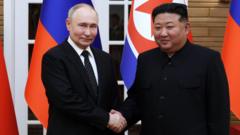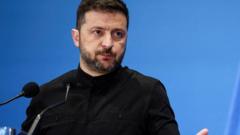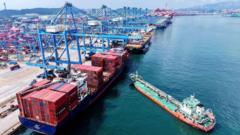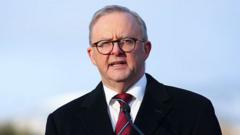President Donald Trump's recent flurry of diplomatic activity has raised questions about the nature of his foreign policy. Engaging on various fronts, from lifting sanctions on Syria to negotiating ceasefires in contentious regions, Trump’s actions demonstrate a marked shift in how the U.S. approaches global relations. While some view these moves as pragmatic diplomacy, others caution about the underlying uncertainties and impulsivity that accompany such swift changes.
**Trump's Rapid Diplomacy: A New Foreign Policy Era?**
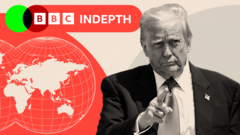
**Trump's Rapid Diplomacy: A New Foreign Policy Era?**
In a whirlwind diplomatic week, President Trump engages multiple global issues, reflecting a shift in U.S. foreign policy approach while leaving allies puzzled.
In a political climate marked by skepticism, Trump ventured into the international arena, promoting trade-centric cooperation over interventionist ideologies previously favored by the U.S. In Saudi Arabia, he outlined a vision prioritizing “commerce over chaos,” securing what was presented as $600 billion in investments for the U.S. The atmosphere was one of grandeur, with Trump enjoying the applause of international dignitaries. Yet, this approach, critics warn, lacked substantive regard for human rights and climate action, focusing instead on immediate economic incentives.
Among his recent high-profile actions, Trump took a notable stance on the violence between India and Pakistan, asserting that the U.S. should remain detached from these conflicts. This message resonated in the Trump administration, with Vice President JD Vance labeling the strife as "none of our business." However, diplomatic pressure still came from Washington as both nations were urged to reach a ceasefire.
Trump's decision-making pattern has drawn scrutiny for centralizing power in his hands, making policy changes with little inter-agency involvement. Clear instances included his abrupt lifting of sanctions on the new Syrian leadership, a move seen as influenced by lobbying from regional allies. This method of policy determination has led to concerns about consistency and reliability in U.S. commitments abroad.
The recent negotiations with China, which involved tariff reductions, illustrated another aspect of Trump's ‘art of the deal’ approach: reacting to volatile market conditions with quick reversals of prior positions. Critics note that while adaptable, such tactics may not be suitable for the long-lasting political and military challenges like those posed by Russia’s actions in Ukraine.
In Israel’s ongoing conflicts and Trump's overtures towards Iran, there lies another dimension of uncertainty. His distancing from Israeli Prime Minister Benjamin Netanyahu during this diplomatic blitz has left observers questioning Israel's stability and responses. The power dynamics in these relationships appear to be shifting, with ripple effects across the Middle East.
In summary, while Trump's diplomatic outreach suggests a proactive stance in international relations, the complexities of these engagements underline an enduring volatility. Critics warn that despite a vigorous push for trade and economic agreements, unresolved conflicts and humanitarian crises in regions like Gaza and Ukraine persist, leaving a gap between ambition and tangible peace. Amid this rapid activity, the question remains whether Trump's mercantilist tendencies can indeed resolve long-standing geopolitical tensions or if they signify a futile race against global instability.
Among his recent high-profile actions, Trump took a notable stance on the violence between India and Pakistan, asserting that the U.S. should remain detached from these conflicts. This message resonated in the Trump administration, with Vice President JD Vance labeling the strife as "none of our business." However, diplomatic pressure still came from Washington as both nations were urged to reach a ceasefire.
Trump's decision-making pattern has drawn scrutiny for centralizing power in his hands, making policy changes with little inter-agency involvement. Clear instances included his abrupt lifting of sanctions on the new Syrian leadership, a move seen as influenced by lobbying from regional allies. This method of policy determination has led to concerns about consistency and reliability in U.S. commitments abroad.
The recent negotiations with China, which involved tariff reductions, illustrated another aspect of Trump's ‘art of the deal’ approach: reacting to volatile market conditions with quick reversals of prior positions. Critics note that while adaptable, such tactics may not be suitable for the long-lasting political and military challenges like those posed by Russia’s actions in Ukraine.
In Israel’s ongoing conflicts and Trump's overtures towards Iran, there lies another dimension of uncertainty. His distancing from Israeli Prime Minister Benjamin Netanyahu during this diplomatic blitz has left observers questioning Israel's stability and responses. The power dynamics in these relationships appear to be shifting, with ripple effects across the Middle East.
In summary, while Trump's diplomatic outreach suggests a proactive stance in international relations, the complexities of these engagements underline an enduring volatility. Critics warn that despite a vigorous push for trade and economic agreements, unresolved conflicts and humanitarian crises in regions like Gaza and Ukraine persist, leaving a gap between ambition and tangible peace. Amid this rapid activity, the question remains whether Trump's mercantilist tendencies can indeed resolve long-standing geopolitical tensions or if they signify a futile race against global instability.




